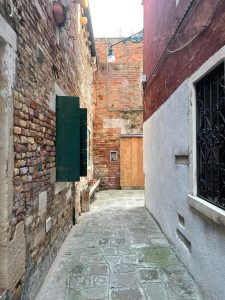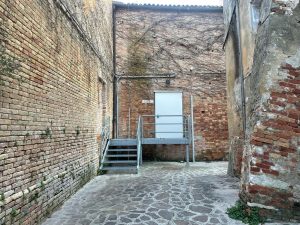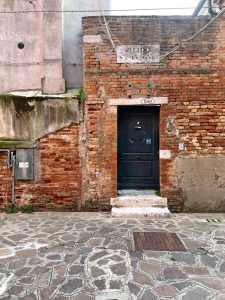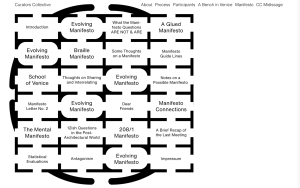May 22, 2021-November 21, 2021
Curated by Hashim Sarkis

Back Doors to the Giardini
It is an open secret that some of the national pavilions in La Biennale di Venezia’s Giardini have a back door. These doors, of different sizes, locations, security systems, and aesthetics, open to side streets outside the exhibition grounds to receive goods, avoid long lines for workers, or sneak in guests and friends. They are shortcuts and loopholes performing alternative politics to the Biennale’s official guidelines, their existence and keys meant to be kept a secret, shared only among those who know. Despite their privileged status, they unleash other forms of relationality across borders that could be appropriated and repurposed.

Figure 1. Back door to the Belgian Pavilion. Photo by Anna Braghini.

Figure 2. Back door to the Netherlands Pavilion. Photo by Anna Braghini.
Yet not all pavilions have back doors. In fact, not all pavilions have doors. Not all countries have pavilions in the Giardini, or have pavilions at all. The Giardini is a park where global geopolitics and colonial and imperial histories are enacted in a festive light, and where solidarity is generally overshadowed by individual and national competition.
The latest edition of La Biennale di Architettura, the 17th, was different. Caught in the middle of a global pandemic, and navigating the uncertainty and control measures prompted by it, the Biennale was postponed several times. When it finally opened on May 22, 2021, the general rush that precedes the event had morphed into a lingering time to evaluate its relevance. The pandemic had dramatically affected the capacity of individuals and national representations to participate, and its extended duration pressured the finances and strength of all involved. It was like being asked to run the marathon all over again when you are about to reach the finish line.
This exceptional condition added weight to the initial question posed by curator Hashim Sarkis: “How will we live together?” The German and Canadian national pavilions remained physically empty. They emphasized the possibilities of the digital space and acknowledged the many who could not be there—while simultaneously alienating some of the on-site visitors. The Russian team leveraged the longue durée into an architectural act, in this case the pavilion’s physical and conceptual renovation. By embracing duration, they interrogated the relevance of today’s institutions, starting from their own. The Japanese team also focused on time-based practices and engaged in social and material construction cycles, deconstruction and reuse. The Americans remained close to the bodybuilding contest, becoming a site to learn from balloon framing, the US construction system par excellence. The Dutch interrogated Sarkis’ curatorial question by posing a counter-question: “Who are we?” In a doorless pavilion, Thailand hinted at similar inquiries by putting an elephant literally in the room, at the center of architecture. The most accurate slogan came from the Portuguese. Cutting short any romantic understanding of a “we,” multiple and in harmony, they responded to the “How will we live together?” question with a bold “In conflict.”
Regrettably, the exhibition’s structure leaves little room for collaboration. The event is seen by professionals as an opportunity to make themselves known in the world or expand their influence in the field. The Biennale holds and lives on the promise and potential of launching, consolidating, or making a difference in a career. It is a space conceived to grant, perform, and perpetuate personal and collective privilege.
Countries enact privilege. At the core of the Giardini’s experience are nationalism and the politics of representation, mediated by the resources that each nation can funnel into this exhibition act. Unevenly distributed resources mirror global conditions. The differences, noticeable among those who have access to this national showroom, heighten when considering those unable to take part. In this year’s edition, many teams were left behind, aside, or simply left out, among them Venezuela and the Czech Republic.
Beyond the space of national representation, this edition’s curators constituted a transnational network of solidarity with the Curators Collective, a coalition of National Pavilion Curators participating in the 17th Biennale. Against this background of uneven distribution, the Curators Collective acquired particular relevance. Whereas knowledge exchange and resource sharing between curatorial teams have previously occurred at the Giardini, this year’s curatorial collaboration constituted a leap forward in scale, visibility, and mobilizing capacity. Alliances became not an exception but the general spirit of the Biennale.

Figure 3. Back door to the Italian Pavilion. Photo by Anna Braghini.
The Curators Collective activities included meetings, workshops, the launch of an open call and a website, and collaborative writing processes. In the latter, the curators embarked on drafting an ever-changing manifesto by bringing questions, perspectives, and ideas together. The methodology and the process became the core of this “Evolving Manifesto,” a dynamic and genuine search for plural authorship and common grounds that unveils possible future strategies for the Biennale and whose open nature didn’t prevent the materialization of ideas in concrete projects.
The Collective constitutes a blueprint and route map for future initiatives at the service of newly appointed curators. It has entirely transformed the curator’s role. From a figure that, unlike commissioners, was not particularly concerned with continuity, to an agent accounting for the collective responsibility, a carrier of ideas, methods, and tactics from generation to generation. The Collective’s work will surely leave a legacy and impact the Biennale’s competitive ethos.

Figure 4. Back door to the Giardini. Photo by Anna Braghini.
The inertia to go back to previous models will probably be strong. Some curators’ urge to put their name under fragments of the Collective’s texts and the Manifesto, thus undermining the notion of collective authorship, already demonstrated the weight of internal politics at play. Still, more decisive may be the peer pressure to continue working together. And yet, one can’t help but wonder if these endeavors should have the Biennale as a focus or if the actions conducted there have resonance outside its walls. Does this space, and similar ones, still hold potential for how we can “live together”?

Figure 5. Curators Collective website (https://curatorscollective.org/manifesto/).
A negative response should provoke architects to endorse a collective act of withdrawal. The long history of Biennale occupations and boycotts makes such action thinkable. Nevertheless, questions remain about the redirection of forces and resources and the possibility of constructing alternative, better-suited institutions. Sometimes there is no other option than to work with and from ruins.
Although it is a site and an institution built upon a system not suited to today’s needs, the Biennale has the capacity to mobilize a collectivity towards something more relevant than itself, and an endeavor that will come neither from its front runners nor its institutional core. For instance, the proposal for incorporating the Curators Collective at The Historical Archives of Contemporary Arts of La Biennale di Venezia (ASAC) as a stable platform supported by La Biennale di Venezia is tempting. Arguably, it could also frame and limit what otherwise will be a genuine and still emergent collective practice.
The Biennale’s critical reinvention demands a systematic, collective commitment to repurposing the work of all involved and the structures that sustain it. One carried out through the back doors already opened and those yet to be, starting with those that undermine nationalism, competition, and short-term thinking.
Across nations. National pavilions are a myopic, obsolete lens for understanding and communicating contemporary architecture and a problematic framework given the growing anti-migrant narratives and xenophobic violence. Curatorial teams and participants could nevertheless cut across existing national representations through transnational forms of governance tuned for the challenges ahead: forms of radical empathy and rightful strategies of redistribution.
Past awards. The Biennale’s most significant role is as a gathering place to make friends, comrades, and allies: a place for knowledge exchange and dialogue where people, ideas, and things come together. Recognitions turn the focus from the collective body to individual authors and perpetuate the architect as a competitive market agent, the ultimate neoliberal subject. Awards hijack the conversation. They downgrade dialogue to competition.
Beyond display. Nebulous curatorial themes combined with an emphasis on display also limit the Biennale’s potential for stimulating change in architectural discourse and practice. Images, videos, fragments, scale, and 1:1 models are generally mobilized to illustrate instead of operate. Yet the Biennale has the potential to become dynamic and generative, a place to put spatial, material, and conceptual models in motion, leading to larger alliances and paradigm shifts.
The Canadian, Catalan, Danish, German, Japanese, and Russian pavilions are among those embracing this opportunity. They are testing grounds and not mere contest displays. Some are architectural sites in spatial and material transformation. Some propose forms of gathering, modes of engagement, material and technological explorations that challenge traditional uses of space. Some investigate alternative institutional formations and social contracts. Some embody a critique of the Biennale’s national representation and associated social and political struggles. Some embrace long-term projects where resources are not directed towards spectacle but to sociopolitical and ecologically relevant research carried out by a large network of collaborators. They all make the exhibition not a neutral vehicle for the presentation of works but an operating platform and primary space of architectural collaboration and practice
These and other back doors—across nations, past awards, and beyond display—enhance access and bypass current barriers preventing collaboration and solidarity at the Biennale. They are ready to be opened and cut across. Now we all know.
Editor’s Note: David Theodore, Associate Editor, Reviews, is a member of the Curators Collective.
Marina Otero Verzier is an architect and head of the Social Design Masters at Design Academy Eindhoven. From 2015 to 2022 she was the director of research at Het Nieuwe Instituut, the Dutch institute for Architecture, Design and Digital Culture. Previously she worked as director of programming at Studio-X GSAPP, a global network of research centers focusing on the future of cities and affiliated with Columbia University. Otero has been a curator at the Shanghai Art Biennial 2021, curator of the Dutch Pavilion at the Venice Architecture Biennale in 2018, and chief curator of the 2016 Oslo Architecture Triennale. She has coedited Lithium: State of Exhaustion (2021), More-than- Human (2020), Architecture of Appropriation (2019), Work, Body, Leisure (2018), and After Belonging (2016), among others. Otero studied at TU Delft and ETSA Madrid and Columbia University GSAPP. Her PhD thesis “Evanescent Institutions” (2016) examines the emergence of new paradigms for institutions, and in particular the political implications of temporal and itinerant structures.
How to Cite This: Otero Verzier, Marina. Review of La Biennale di Venezia 17th International Architecture Exhibition, curated by Hashim Sarkis, Venice, May 22 – November 21, 2021, JAE Online, March 11, 2022.






